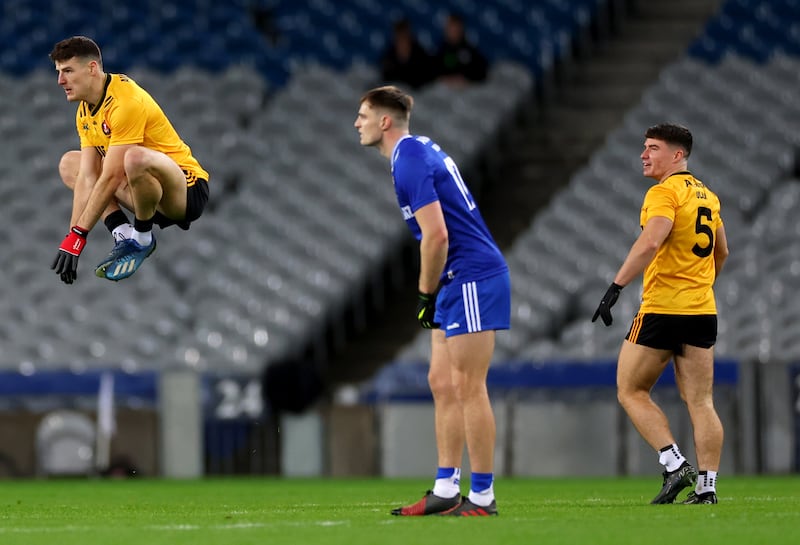The first thing you’d say about the weekend is that the Football Review Committee (FRC) are some men to do a sales pitch. It’s a long time since I’ve seen anything happen in the GAA that was as carefully choreographed as the presentation they put on. The matching bodywarmers alone tell you how serious Jim Gavin and his committee are about getting this over the line.
Think about it — you don’t just decide on a Wednesday that everybody is going to be wearing matching gear on a Friday. These were specifically designed, with Gaelic Football Review Committee 2024/25 sewn into each one.
So that means that somewhere along the way, probably months ago, in the middle of everything else they were doing, someone on the committee made sure that new gear was designed, fitted and ordered for each member so that they’d look the part when the time came to roll everything out. Nothing was happening by accident.
Between Friday night and Saturday night, the co-commentary on TG4 and RTÉ was heavy on the propaganda. It felt like every time there was a score, either Eamonn Fitzmaurice or Jim Gavin was highlighting the rule change that brought it about. That’s fair enough — for those fellas, the weekend was about selling these rules to an audience that hadn’t seen them before.
READ MORE
But the whole drive for positivity obviously filtered down to the players on Friday night. You could see that they were trying things they wouldn’t normally do, trying to showcase the rules instead of playing a game of football. It was as if the FRC had given them a load of new rule vouchers beforehand and told them they had to go and get full value out of them.
That’s no use to anyone. Sport at the top level is always far more interested in getting around the rules than it is about enjoying them. What the FRC needed more than anything else was for teams to come out and act the bollocks. People aren’t fools — they know what they saw on Friday night might have been enjoyable but it wasn’t really football.
[ New football rules: Largely successful outing puts the ball in the GAA’s courtOpens in new window ]

This is why I wasn’t surprised at all to see the teams try to get a bit more control over the whole thing on Saturday. Especially Ulster. I know if I’d have been in one of those squads and we were having a bit of a debrief over a few pints on Friday night, I’d have been making the case for stalling the ball a bit more. You can’t be going gung-ho all the time. You have to find a way to take your breather.
Ultimately, there’s no point in everyone sitting around in October high-fiving ourselves because football was saved over a weekend of matches that nobody cared about. When a competition ends with two teams laughing and smiling their way through a penalty shoot-out, that tells you how little pressure the players and coaches were under. We won’t know how these rules work until the league.
For now, I find lots to like in them. The solo-and-go, the one v one for throw-ins, the 40m arc for kick-outs — I think they’re all very good ideas. The first two speed up the game and cut out messing and the kick-out one makes the battle around the middle crucial to the game.
I love the shaving foam on the ground, free-takers have been robbing yards for years. And it was noticeable throughout the weekend that there was a big emphasis on referees to keep an eye on the steps’ rule. This was long overdue. It’s not a new rule, obviously, but won’t be long feeling new if they’re consistent on it from here on out.

Here’s where we get to the crux of the whole thing. Rules are rules — but referees are referees too. And my one significant concern with the whole enterprise is how referees are going to handle it all. It’s not that the rule changes are all that difficult to referee — it’s more that they make the referee an even more central figure in every game, especially while they’re bedding in.
For example, I love the 50m rule for dissent or for delaying an opposition free. I think it’s probably the best of the new rules when it comes right down to it. Being able to move the ball up 50m is dramatic in any game and you’d have to think it will be a huge deterrent to giving backchat.
But there’s a fair chance it’s going to be messy too, especially as you go away down through the grades. Intercounty players have the cop-on to realise quickly that they won’t last long if they’re continually giving away half the pitch. But you’re looking at a huge culture change at club level.

Referees are going to be the focus of that culture change and the pressure on them is going to be huge. I know all the scare stories are about how they’re not going to be able to spot whether three from each side are up or whether a kicker is inside the 40m arc. But the 50m thing is such a heavy punishment — and such a noticeable one.
Every one of them is automatically a big decision. You’re going to see plenty of fellas done for overcarrying in an attacking position and if they hang on to the ball for a split second too long after the whistle, it’s more or less a guaranteed score at the other end.
But what’s too long? Does it change from referee to referee? From game to game? From province to province? That’s grey-area stuff, which is where referees tend to get on the wrong side of one crowd or the other. They are going to have to be very strong throughout the next year to see this whole thing through.
This weekend was still just the theory test. In practice, there’s a long way to go yet.















